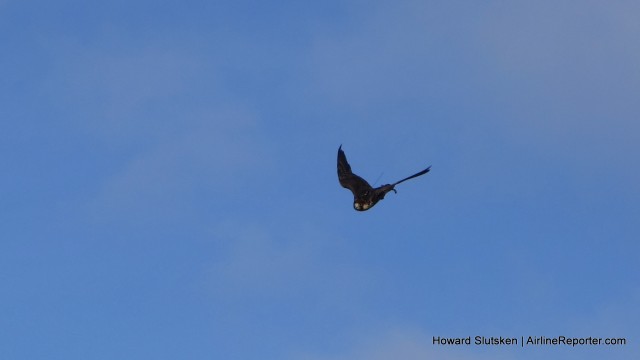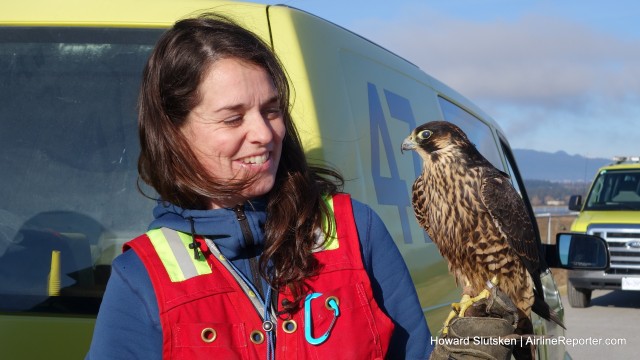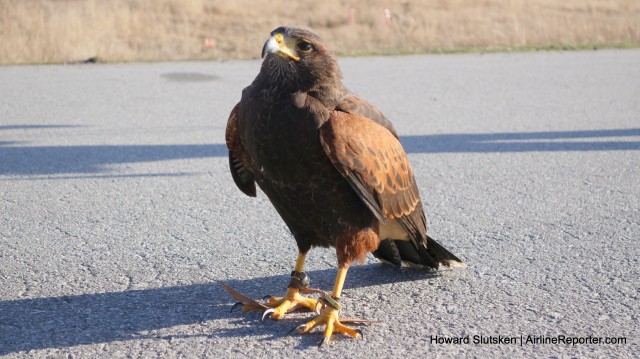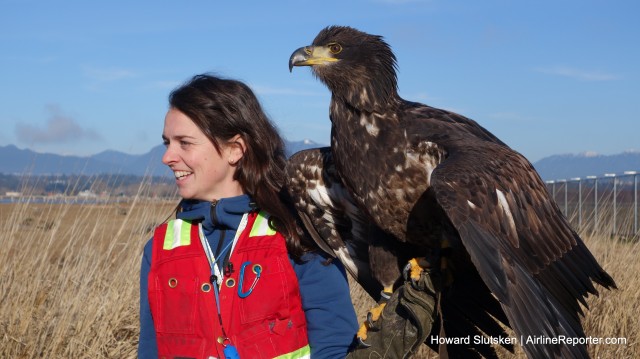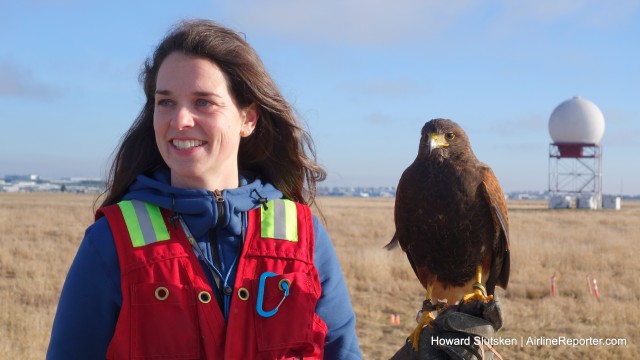
Emily Fleming, Raptor Biologist with Pacific Northwest Raptors, and Goliath, the Harris’ Hawk, in front of YVR’s radar “golf ball”
Airplanes and birds don’t play well together.
Just ask Captain Sully and First Officer Jeff, whose encounter with a flock of Canada Geese turned their A320 into a glider. Or talk to the crews of the approximately 150 planes per year at Vancouver International Airport that report bird strikes. Flight safety can be seriously compromised, repair costs for the airlines are huge, passengers are often inconvenienced, and for the birds, well, it’s fatal.
Vancouver International Airport (YVR) is located on the shores of the Strait of Georgia, on a large island in the Fraser River Delta. And just like the passengers who connect at YVR, the millions of birds that annually use the migratory Pacific Flyway like to stop in the Vancouver area to get something to eat and have a rest. Boundary Bay, south of YVR and the location of the general aviation Boundary Bay Airport (ZBB), is an internationally-recognized Important Bird Area. Even the main Vancouver air navigation aid, the YVR VOR, is on the same island as the renowned Reifel Migratory Bird Sanctuary.
YVR has a Wildlife Management Department that works 24/7 to keep birds and planes safely apart. YVR’s two main runways are oriented east-west, and the mile-wide open space between the runways, west of the terminals to the shore, is a favorite stop for the birds. Wildlife Management Specialist Dave Bradbeer heads a 15-person team that uses a variety of methods to keep birds away from the critical zones at YVR. Pyrotechnics, dogs, lights, and even lasers have been used to move flocks of birds as large as snow geese, and as small as swallows. However, the birds get used to the sound effects, the light shows, and even the dogs, and often return. But the sight or shadow of a hunting bird over a flock gets the birds moving – fast!
In the past, the Wildlife Management Team had considered the use of raptors, and something happened a couple of years ago that got them serious about the birds of prey. Brett Patterson, YVR’s Director – Airside Operations, told me that the Team was out to move flocks of Dunlins, a small wading bird, from the shoreline. They couldn’t figure out why they didn’t see any of the birds, until someone noticed a Peregrine Falcon sitting on top of the “golf ball” radar enclosure near the shore. The falcon flew off, but the Dunlins stayed away for another two days. Clearly, the Dunlins had been scared off by the falcon.
So last year, YVR set up a pilot project in association with Pacific Northwest Raptors. PNWR raises raptors in captivity, and trains the birds to return to their handlers for a food reward. At the airport, the raptor flies back-and-forth between its widely-separated handlers. That’s more than enough to make an impression on the shore birds. The pilot project was a success, and the airport quickly moved to make raptors a permanent part of the team.
Dash, the Peregrine Falcon, is amazingly maneuverable and incredibly fast. Peregrines have been clocked at well over 200 mph (322 kph). I got an example of Dash’s speed when he dove down to his lure, passing about a foot over my head. The sound of his fly-by was phenomenal. Dash works the Dunlins, and will even chase ducks twice his size. He’s small and hard to spot, so he has a locator transmitter and antenna on his back to help his handlers find him. Dash trades recon duties with his partner, Jet.
Goliath, or “Golly” to his friends, is a two-year old, male Harris’ Hawk. He’s about the same size as Dash, weighs in at around 25 oz (710 g), and has wingspan a bit over 3 ft (1 m). He seems to be a bit of a ham; he stopped and held still for a photo. Harris’ Hawks are unique – unlike other birds of prey, they normally hunt in family packs, and are very accepting of humans as part of their group.
And then there’s Hercules. He’s huge. Hercules is a juvenile, two-year-old Bald Eagle. He has a few more years before his coloring starts to change to a mature bird’s white head and tail. Like most youngsters, Hercules is very talkative and squawks continually, but his call isn’t very nice. It’s actually more of a loud, piercing squeal. So when you’ve seen and heard Bald Eagles in movies or on TV, their call is usually overdubbed with that of the more-melodious Red-Tailed Hawk.
Hercules is very effective at scaring away flocks of large Snow Geese. The Snow Geese don’t pay too much attention when a falcon or a hawk flies over, but they scatter when Hercules shows up. We didn’t get to meet Jet, or the other two members of the squadron – Gyrby, a Gyr Falcon, and Phantom, a hybrid Gyr-Saker Falcon.
So next time you fly into YVR, have a look out the window and check out the shoreline. You might see Dash, Goliath, Hercules, or their friends, on patrol to keep you safe.
